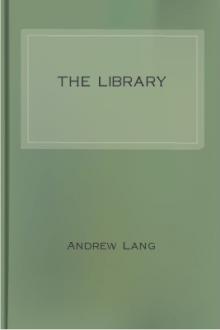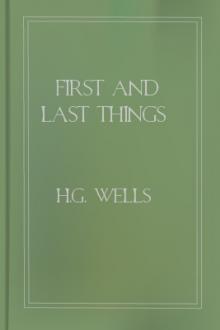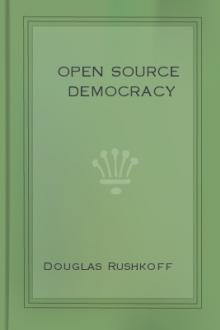The Library by Andrew Lang (i have read the book a hundred times txt) 📕

- Author: Andrew Lang
- Performer: -
Book online «The Library by Andrew Lang (i have read the book a hundred times txt) 📕». Author Andrew Lang
Unfortunately he almost always finds that he has been forestalled, probably by some bookseller’s agent. When the catalogue is a French one, it is obvious that Parisians have the pick of the market before our slow letters reach M. Claudin, or M. Labitte. Still the catalogues themselves are a kind of lesson in bibliography. You see from them how prices are ruling, and you can gloat, in fancy, over De Luyne’s edition of Moliere, 1673, two volumes in red morocco, double (“Trautz Bauzonnet”), or some other vanity hopelessly out of reach. In their catalogues, MM. Morgand and Fatout print a facsimile of the frontispiece of this very rare edition. The bust of Moliere occupies the centre, and portraits of the great actor, as Sganarelle and Mascarille (of the “Precieuses Ridicules”), stand on either side. In the second volume are Moliere, and his wife Armande, crowned by the muse Thalia. A catalogue which contains such exact reproductions of rare and authentic portraits, is itself a work of art, and serviceable to the student. When the shop of a bookseller, with a promising catalogue which arrives over night, is not too far distant, bibliophiles have been known to rush to the spot in the grey morning, before the doors open. There are amateurs, however, who prefer to stay comfortably at home, and pity these poor fanatics, shivering in the rain outside a door in Oxford Street or Booksellers’ Row. There is a length to which enthusiasm cannot go, and many collectors draw the line at rising early in the morning. But, when we think of the sport of book-hunting, it is to sales in auction-rooms that the mind naturally turns. Here the rival buyers feel the passion of emulation, and it was in an auction-room that Guibert de Pixerecourt, being outbid, said, in tones of mortal hatred, “I will have the book when your collection is sold after your death.” And he kept his word. The fever of gambling is not absent from the auction-room, and people “bid jealous” as they sometimes “ride jealous” in the hunting-field.
Yet, the neophyte, if he strolls by chance into a sale-room, will be surprised at the spectacle. The chamber has the look of a rather seedy “hell.” The crowd round the auctioneer’s box contains many persons so dingy and Semitic, that at Monte Carlo they would be refused admittance; while, in Germany, they would be persecuted by Herr von Treitschke with Christian ardour. Bidding is languid, and valuable books are knocked down for trifling sums. Let the neophyte try his luck, however, and prices will rise wonderfully. The fact is that the sale is a “knock out.” The bidders are professionals, in a league to let the volumes go cheap, and to distribute them afterwards among themselves. Thus an amateur can have a good deal of sport by bidding for a book till it reaches its proper value, and by then leaving in the lurch the professionals who combine to “run him up.” The amusement has its obvious perils, but the presence of gentlemen in an auction-room is a relief to the auctioneer and to the owner of the books. A bidder must be able to command his temper, both that he may be able to keep his head cool when tempted to bid recklessly, and that he may disregard the not very carefully concealed sneers of the professionals.
In book-hunting the nature of the quarry varies with the taste of the collector. One man is for bibles, another for ballads. Some pursue plays, others look for play bills. “He was not,” says Mr.
Hill Burton, speaking of Kirkpatrick Sharpe, “he was not a black-letter man, or a tall copyist, or an uncut man, or a rough-edge man, or an early-English dramatist, or an Elzevirian, or a broadsider, or a pasquinader, or an old brown calf man, or a Grangerite, {1} or a tawny moroccoite, or a gilt topper, or a marbled insider, or an editio princeps man.” These nicknames briefly dispose into categories a good many species of collectors. But there are plenty of others. You may be a historical-bindings man, and hunt for books that were bound by the great artists of the past and belonged to illustrious collectors. Or you may be a Jametist, and try to gather up the volumes on which Jamet, the friend of Louis Racine, scribbled his cynical “Marginalia.” Or you may covet the earliest editions of modern poets—Shelley, Keats, or Tennyson, or even Ebenezer Jones.
Or the object of your desires may be the books of the French romanticists, who flourished so freely in 1830. Or, being a person of large fortune and landed estate, you may collect country histories. Again, your heart may be set on the books illustrated by Eisen, Cochin, and Gravelot, or Stothard and Blake, in the last century. Or you may be so old-fashioned as to care for Aldine classics, and for the books of the Giunta press. In fact, as many as are the species of rare and beautiful books, so many are the species of collectors. There is one sort of men, modest but not unwise in their generations, who buy up the pretty books published in very limited editions by French booksellers, like MM. Lemerre and Jouaust. Already their reprints of Rochefoucauld’s first edition, of Beaumarchais, of La Fontaine, of the lyrics attributed to Moliere, and other volumes, are exhausted, and fetch high prices in the market. By a singular caprice, the little volumes of Mr.
Thackeray’s miscellaneous writings, in yellow paper wrappers (when they are first editions), have become objects of desire, and their old modest price is increased twenty fold. It is not always easy to account for these freaks of fashion; but even in book-collecting there are certain definite laws. “Why do you pay a large price for a dingy, old book,” outsiders ask, “when a clean modern reprint can be procured for two or three shillings?” To this question the collector has several replies, which he, at least, finds satisfactory. In the first place, early editions, published during a great author’s lifetime, and under his supervision, have authentic texts. The changes in them are the changes that Prior or La Bruyere themselves made and approved. You can study, in these old editions, the alterations in their taste, the history of their minds. The case is the same even with contemporary authors. One likes to have Mr. Tennyson’s “Poems, chiefly Lyrical” (London: Effingham Wilson, Royal Exchange, Cornhill, 1830). It is fifty years old, this little book of one hundred and fifty-four pages, this first fruit of a stately tree. In half a century the poet has altered much, and withdrawn much, but already, in 1830, he had found his distinctive note, and his “Mariana” is a masterpiece. “Mariana” is in all the collections, but pieces of which the execution is less certain must be sought only in the old volume of 1830. In the same way “The Strayed Reveller, and other poems, by A.” (London: B. Fellowes, Ludgate Street, 1849) contains much that Mr. Matthew Arnold has altered, and this volume, like the suppressed “Empedocles on Etna, and other Poems, by A.” (1852), appeals more to the collector than do the new editions which all the world may possess. There are verses, curious in their way, in Mr. Clough’s “Ambarvalia” (1849), which you will not find in his posthumous edition, but which “repay perusal.” These minutiae of literary history become infinitely more important in the early editions of the great classical writers, and the book-collector may regard his taste as a kind of handmaid of critical science. The preservation of rare books, and the collection of materials for criticism, are the useful functions, then, of book-collecting. But it is not to be denied that the sentimental side of the pursuit gives it most of its charm. Old books are often literary relics, and as dear and sacred to the lover of literature as are relics of another sort to the religious devotee. The amateur likes to see the book in its form as the author knew it. He takes a pious pleasure in the first edition of “Les Precieuses Ridicules,” (M.DC.LX.) just as Moliere saw it, when he was fresh in the business of authorship, and wrote “Mon Dieu, qu’un Autheur est neuf, la premiere fois qu’on l’imprime.” All editions published during a great man’s life have this attraction, and seem to bring us closer to his spirit. Other volumes are relics, as we shall see later, of some famed collector, and there is a certain piety in the care we give to books once dear to Longepierre, or Harley, or d’Hoym, or Buckle, to Madame de Maintenon, or Walpole, to Grolier, or Askew, or De Thou, or Heber.
Such copies should be handed down from worthy owners to owners not unworthy; such servants of literature should never have careless masters. A man may prefer to read for pleasure in a good clear reprint. M. Charpentier’s “Montaigne” serves the turn, but it is natural to treasure more “Les Essais de Michel Seigneur de Montaigne,” that were printed by Francoise le Febre, of Lyon, in 1595. It is not a beautiful book; the type is small, and rather blunt, but William Drummond of Hawthornden has written on the title-page his name and his device, Cipresso e Palma. There are a dozen modern editions of Moliere more easily read than the four little volumes of Wetstein (Amsterdam, 1698), but these contain reduced copies of the original illustrations, and here you see Arnolphe and Agnes in their habits as they lived, Moliere and Mdlle. de Brie as the public of Paris beheld them more than two hundred years ago.
Suckling’s “Fragmenta Aurea” contain a good deal of dross, and most of the gold has been gathered into Miscellanies, but the original edition of 1646, “after his own copies,” with the portrait of the jolly cavalier who died aetatis suae 28, has its own allurement.
Theocritus is more easily read, perhaps, in Wordsworth’s edition, or Ziegler’s; but that which Zacharias Calliergi printed in Rome (1516), with an excommunication from Leo X. against infringement of copyright, will always be a beautiful and desirable book, especially when bound by Derome. The gist of the pious Prince Conti’s strictures on the wickedness of comedy may be read in various literary histories, but it is natural to like his “Traite de la Comedie selon la tradition de l’Eglise, Tiree des Conciles et des saints Peres,” published by Lovys Billaine in 1660, especially when the tract is a clean copy, arrayed in a decorous black morocco.
These are but a few common examples, chosen from a meagre little library, a “twopenny treasure-house,” but they illustrate, on a minute scale, the nature of the collector’s passion,—the character of his innocent pleasures. He occasionally lights on other literary relics of a more personal character than mere first editions. A lucky collector lately bought Shelley’s copy of Ossian, with the poet’s signature on the title-page, in Booksellers’ Row. Another possesses a copy of Foppens’s rare edition of Petrarch’s “Le Sage Resolu contre l’une et l’autre Fortune,” which once belonged to Sir Hudson Lowe, the gaoler of Napoleon, and may have fortified, by its stoical maxims, the soul of one who knew the extremes of either fortune, the captive of St. Helena. But the best example of a book, which is also a relic, is the “Imitatio Christi,” which belonged to J. J. Rousseau. Let M. Tenant de Latour, lately the happy owner of this possession, tell his own story of his treasure: It was in 1827
that M. de Latour was walking on the quai of the Louvre. Among the volumes in a shop, he noticed a shabby little copy of the “Imitatio Christi.” M. de Latour, like other bibliophiles, was not in the habit of examining stray copies of this work, except when they





Comments (0)